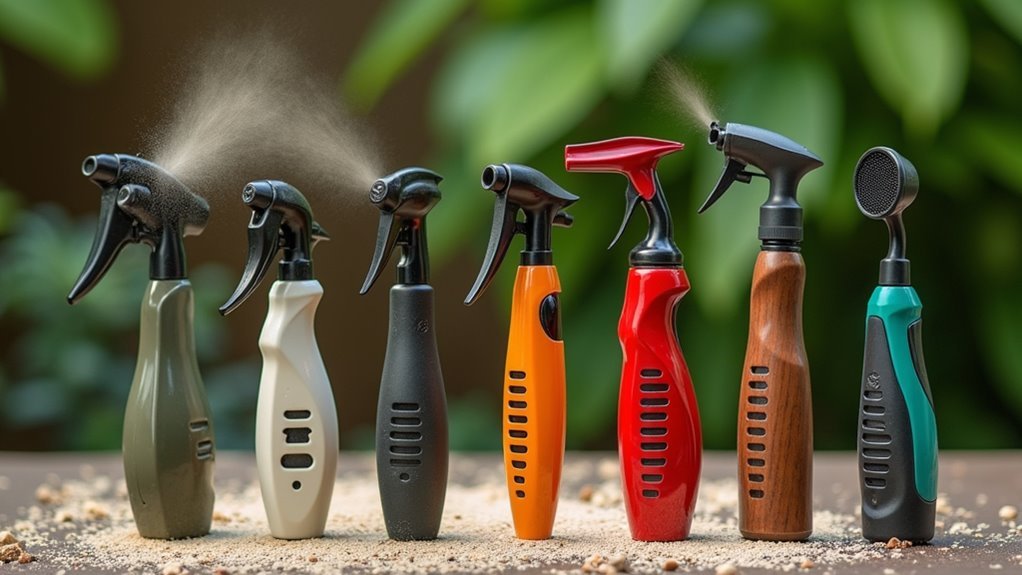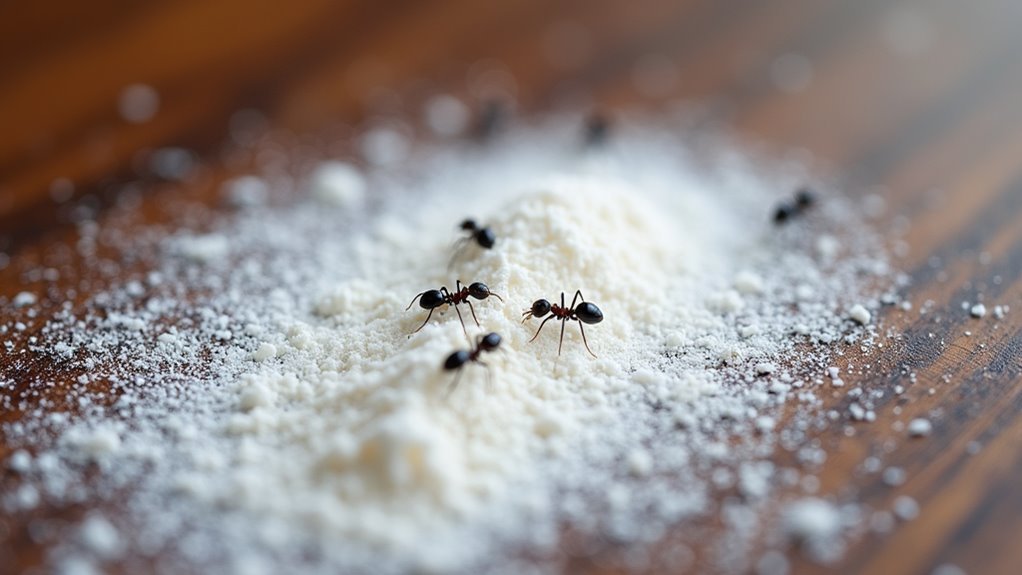You’re likely familiar with pyrethrin’s effectiveness against garden pests, but have you considered alternatives derived purely from flowers? These natural solutions offer powerful pest control without the environmental concerns of synthetic options. They’ll protect your edible crops and ornamentals while breaking down quickly, leaving no harmful residue. If you’re committed to eco-friendly gardening practices, these top-rated flower-based alternatives deserve your attention – and they might just transform your approach to pest management.
Bonide Pyrethrin Garden Insect Spray Concentrate (8 oz)
Gardeners seeking a fast-acting solution will find Bonide’s concentrate particularly effective against common garden invaders. This 8 oz bottle targets aphids, beetles, webworms, and leafhoppers by disrupting their nervous systems.
You’ll appreciate its versatility – mix 3 tablespoons with a gallon of water to treat vegetables like tomatoes and beans, or ornamentals including roses and azaleas. The chrysanthemum-derived active ingredient breaks down naturally in the environment.
What makes this product especially valuable for edible gardens is that you can safely use it right up until harvest day without worrying about harmful residues on your produce.
Best For: Home gardeners who need a versatile, fast-acting insecticide that can be safely used on both edible crops and ornamental plants right up to harvest day.
Pros:
- Derived from natural chrysanthemum flowers, making it a more environmentally friendly option that biodegrades naturally
- Extremely versatile application across vegetables, fruits, and ornamental plants with simple mixing instructions
- Can be applied on the day of harvest without leaving harmful residues on edible crops
Cons:
- Requires mixing with water before each application, which adds an extra preparation step
- 8 oz bottle size may not be sufficient for larger garden areas without purchasing multiple bottles
- May need frequent reapplication as pyrethrin breaks down quickly in the environment
Southern Ag 10401 Natural Pyrethrin Concentrate, 8oz, Brown/A
Organic enthusiasts seeking a potent yet natural insecticide solution will find Southern Ag’s Pyrethrin Concentrate a versatile workhorse for their pest control arsenal. This 8oz bottle packs a powerful 0.96% pyrethrin formula that effectively targets aphids, beetles, mosquitoes, and dozens of other pests.
You’ll appreciate its flexibility—use it on vegetables, ornamentals, pets, or livestock with proper dilution (typically 0.24-0.72 tablespoons per gallon). Apply at dusk to protect beneficial insects, and make certain you’re wearing protective gear during application. The concentrated formula means this small bottle can last multiple seasons, making it economical despite its potency.
Best For: Organic gardeners, homesteaders, and small-scale farmers seeking a natural but effective insecticide for multiple applications across vegetables, ornamentals, pets, and livestock.
Pros:
- Versatile natural formula effectively controls a wide range of pests including aphids, whiteflies, beetles, and mosquitoes
- Concentrated solution is economical, with an 8oz bottle lasting multiple growing seasons when properly diluted
- Quick-acting knockdown effect on insects while breaking down rapidly in the environment
Cons:
- Non-selective formula kills beneficial insects like bees and ladybugs if not applied carefully at dusk
- Requires protective gear (mask, eye protection, long clothing) during application for user safety
- Must make direct contact with insects to be effective, requiring thorough coverage and possibly multiple applications
Bonide Pyrethrin Garden Insect Spray Concentrate (16 oz)
While biodegradable and fast-acting, the Bonide Pyrethrin Garden Insect Spray Concentrate offers a powerful solution for anyone seeking effective pest control right up to harvest day. This 16oz concentrate efficiently tackles aphids, beetles, webworms, and leafhoppers while leaving no objectionable residue on your produce.
You’ll appreciate its versatility – it protects everything from vegetables like tomatoes and broccoli to ornamentals like roses and azaleas. Users consistently praise its effectiveness, recommending application every 10 days until pests disappear. The chrysanthemum-derived formula mixes easily with water and can be applied using various sprayers, making this 4.6-star rated concentrate a reliable addition to your gardening arsenal.
Best For: Home gardeners looking for a versatile, fast-acting insecticide that can be used on various plants and vegetables up to the day of harvest.
Pros:
- Effective against a wide range of garden pests including aphids, beetles, webworms, and leafhoppers
- Biodegradable formula derived from chrysanthemum flowers leaves no objectionable residue on produce
- Highly versatile application suitable for vegetables, trees, flowers, and ornamental shrubs
Cons:
- Requires regular reapplication (every 10 days) for complete pest elimination
- Contains pyrethrin which, though natural, still requires careful handling as an insecticide
- Some users report a noticeable smell, though it dissipates quickly after application
Factors to Consider When Choosing Top-Rated Pyrethrin Alternatives Derived Purely From Flowers
When selecting flower-derived pyrethrin alternatives, you’ll want to verify botanical origin authenticity and compare chemical compositions to ascertain comparable efficacy. Consider the range of insects each alternative targets and how quickly the substance breaks down in the environment after application. How the botanical insecticide is harvested directly impacts its potency, so look for products that detail their extraction methods on the label.
Botanical Origin Authenticity
To guarantee you’re getting authentic, flower-derived alternatives to pyrethrin, botanical origin verification should be your first priority. Look for products that clearly state their botanical sources, similar to how genuine pyrethrin comes specifically from Chrysanthemum cinerariifolium and Chrysanthemum coccineum flowers.
Authentic botanical alternatives should feature transparency about extraction methods and concentration levels. Just as pure pyrethrin typically contains 0.96% to 3% active ingredients, legitimate plant-based alternatives will provide similar concentration details.
Check product labels for verification of biodegradability and environmental impact. True botanical insecticides break down quickly in nature, minimizing ecological harm compared to synthetic options. Avoid products that mix natural extracts with synthetic chemicals, as these blends compromise both the authenticity and eco-friendly benefits you’re seeking in a flower-derived alternative.
Chemical Composition Comparison
Understanding the chemical composition of flower-derived pyrethrin alternatives reveals essential differences that affect both efficacy and environmental impact. When evaluating alternatives, you’ll want to examine their active ingredient concentration, which should compare favorably to pyrethrin’s typical 0.96-1.0% formulation.
Look for compounds that mimic pyrethrin’s neurotoxic mechanism but with improved stability against sunlight degradation. The best alternatives maintain biodegradability without harmful residues on crops. Some flower-derived options contain natural synergists that enhance effectiveness without requiring synthetic additives like piperonyl butoxide.
Consider how the alternative’s chemical structure affects beneficial insects. Ideal compounds offer selective toxicity that targets pests while minimizing impact on pollinators. The most promising flower-derived alternatives balance potent insecticidal properties with rapid environmental breakdown, providing effective pest control without persistent ecological consequences.
Insect Target Range
Selecting the most effective pyrethrin alternative requires careful assessment of which pests you’re targeting in your garden or agricultural space. Unlike synthetic options, flower-derived alternatives often have specific pest targets rather than the broad-spectrum approach of traditional pyrethrins.
When choosing your flower-based insecticide, match the product’s effectiveness profile with your specific pest problems. Some botanical alternatives excel against soft-bodied insects like aphids and whiteflies, while others target beetles or caterpillars more effectively. Consider application timing—many flower-derived products work best when applied during pests’ vulnerable life stages.
Remember that truly selective alternatives can preserve beneficial insects like pollinators and predatory species that help maintain garden balance. The ideal product will control your target pests while minimizing impact on the beneficial insects you want to protect.
Environmental Breakdown Rate
When comparing flower-based pyrethrin alternatives, their environmental persistence represents a critical factor in making an eco-conscious choice. Traditional pyrethrin sets a high standard with its impressive 1-3 day breakdown period when exposed to sunlight and moisture.
As you evaluate alternatives, prioritize options that match or exceed pyrethrin’s rapid biodegradability. The best flower-derived substitutes won’t linger in soil or water, breaking down quickly through natural microbial activity. This swift degradation considerably reduces risks to beneficial insects, aquatic life, and other non-target organisms.
Look for products that clearly state their environmental half-life and degradation pathways. Remember that quick breakdown doesn’t necessarily mean reduced effectiveness—it simply guarantees that your pest control solution won’t create lasting ecological impacts after serving its purpose.
Harvesting Methods Matter
The sustainable harvesting practices behind your flower-derived pyrethrin alternatives directly impact both effectiveness and environmental footprint. When selecting products, look for those harvested during ideal flower maturity, typically right before full bloom when essential oil concentration peaks.
Unlike synthetic options, timing matters greatly with flower-derived alternatives. Products harvested at dusk generally contain higher concentrations of active compounds, mirroring the recommended application time that protects beneficial insects.
Consider alternatives harvested through steam distillation rather than chemical extraction, as this preserves biodegradability while extending shelf life. Since these natural compounds break down quickly (similar to pyrethrin’s rapid environmental breakdown), freshness indicators on packaging become vital selection factors.
The best alternatives will specify their harvesting methods, allowing you to balance immediate effectiveness with your long-term garden health goals.
Concentration vs. Effectiveness
Many gardeners mistakenly believe higher concentrations always deliver better results when choosing flower-derived pyrethrin alternatives. While higher concentrations (typically between 0.96% and 1.5%) do correlate with quicker pest knockdown, they’re not always necessary for effective control.
You’ll want to evaluate the dilution rates recommended on product labels. Sometimes a lower-concentration formula applied in larger volumes achieves similar results while posing less risk to beneficial insects. Products containing synergists like piperonyl butoxide often allow for lower pyrethrin concentrations while maintaining effectiveness against a wider pest range.
Remember that these botanical insecticides break down quickly. Their biodegradable nature means you’ll likely need repeated applications regardless of concentration. The ideal balance comes from matching concentration to your specific pest problem rather than automatically choosing the strongest available option.
Plant Safety Profiles
Although nearly all botanical insecticides are marketed as “natural,” different flower-derived pyrethrin alternatives affect plant tissues in notably different ways. When evaluating pyrethrin replacements, prioritize options that break down rapidly in the environment to minimize residual impact on your garden’s ecosystem.
The best alternatives will allow you to harvest edibles immediately after application, similar to pyrethrin’s day-of-harvest safety profile. Look for formulations specifically designed to target pest insects while preserving beneficial pollinators and predators.
Application technique matters greatly—products requiring complete leaf coverage (both top and bottom surfaces) offer better protection without damaging delicate plant tissues. Always follow recommended dilution rates and apply during evening hours to prevent potential leaf burn and stress, especially on sensitive ornamentals and young vegetable plants.
Frequently Asked Questions
Can Pyrethrin Alternatives Be Used on Edible Plants and Herbs?
Yes, you can use some pyrethrin alternatives on edible plants and herbs. Look for products specifically labeled as food-safe with clear harvest waiting periods. Always wash produce thoroughly before consumption for safety.
How Long Do Flower-Derived Insecticides Remain Effective After Application?
Flower-derived insecticides typically remain effective for 3-7 days after you’ve applied them. You’ll need to reapply after rain or irrigation. They’re short-lived because they break down quickly in sunlight and air.
Are These Alternatives Safe for Beneficial Insects Like Bees?
No, flower-derived insecticides aren’t completely safe for beneficial insects. You’ll need to apply them in the evening when bees aren’t active, as they’ll still harm pollinators upon direct contact.
Can Flower-Derived Pyrethrin Alternatives Be Used Indoors?
Yes, you can use flower-derived pyrethrin alternatives indoors. They’re generally safe for home use when properly applied. Just guarantee you follow product instructions and ventilate the area well after application for best results.
Do These Natural Alternatives Work Against Resistant Pest Populations?
Natural alternatives can help against resistant pests. They work differently than synthetic insecticides, so you’ll often get better results. You should rotate different natural solutions to prevent pests from developing new resistance.





Leave a Reply